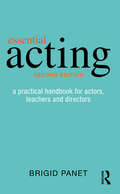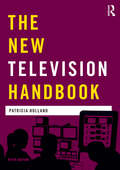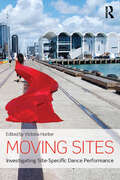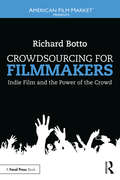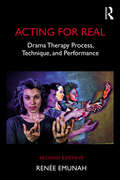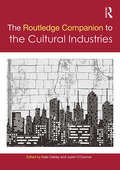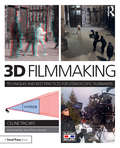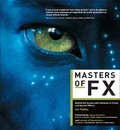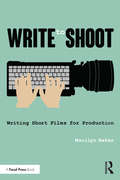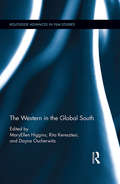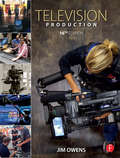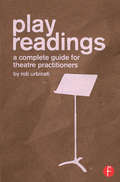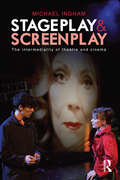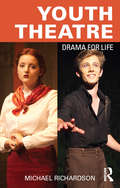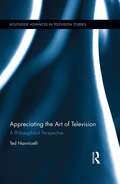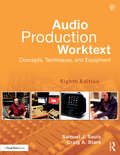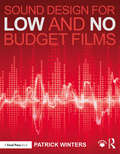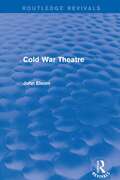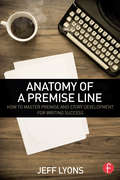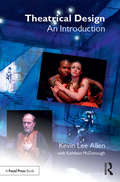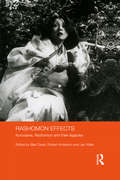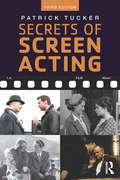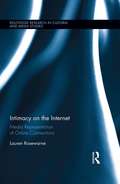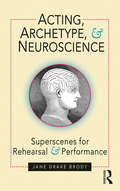- Table View
- List View
Essential Acting: A Practical Handbook for Actors, Teachers and Directors
by Brigid PanetHow do actors fuse thought, emotion and action within their creative process? Essential Acting is an inspired and reliable toolbox for actors and teachers in the classroom, the rehearsal room and the workshop. RADA’s Brigid Panet has distilled nearly 60 years of acting, directing and actor training into a unique recipe which brilliantly combines the teachings of Stanislavsky and Laban into an invaluable practical resource. These exercises are built around the need for simple, achievable techniques that can be applied by actors, teachers and directors to answer the myriad requirements of actor training. The goal is to produce a continuous level of achievement, addressing: • How to rehearse • How to work with a text • How to audition for drama school • How to access the truth of feelings and actions Essential Acting will be a must-have purchase for anyone looking for a comprehensive study guide to the necessary work of the actor.
The New Television Handbook (Media Practice)
by Patricia HollandThe New Television Handbook?provides an exploration of the theory and practice of television at a time when the medium is undergoing radical changes. The book looks at television from the perspective of someone new to the industry, and explores the place of the medium within a?constantly changing digital landscape. This title discusses key skills involved in television production, including: producing, production management, directing, camera, sound, editing and visual effects. Each of these activities is placed within a wider context as it traces the production process from commissioning to post-production. The book outlines the broad political and economic context of the television industry. It gives an account of television genres, in particular narrative, factual programmes and news, and it considers the academic discipline of media studies and the ways in which theorists have analysed and tried to understand the medium. It points to the interplay of theory and practice as it draws on the history of the medium and observes the ways in which the past continues to influence and invigorate the present. The New Television Handbook?includes: contributions from practitioners ranging from established producers to new entrants; a comprehensive list of key texts and television programmes; a revised glossary of specialist terms; a section on training and ways of getting into the industry. By combining theory, real-world advice and a detailed overview of the industry and its history,?The New Television Handbook?is an ideal guide for students of media and television studies and young professionals entering the television industry.
Moving Sites: Investigating Site-Specific Dance Performance
by Victoria HunterMoving Sites explores site-specific dance practice through a combination of analytical essays and practitioner accounts of their working processes. In offering this joint effort of theory and practice, it aims to provide dance academics, students and practitioners with a series of discussions that shed light both on approaches to making this type of dance practice, and evaluating and reflecting on it. The edited volume combines critical thinking from a range of perspectives including commentary and observation from the fields of dance studies, human geography and spatial theory in order to present interdisciplinary discourse and a range of critical and practice-led lenses through which this type of work can be considered and explored. In so doing, this book addresses the following questions: · How do choreographers make site-specific dance performance? · What occurs when a moving body engages with site, place and environment? · How might we interpret, analyse and evaluate this type of dance practice through a range of theoretical lenses? · How can this type of practice inform wider discussions of embodiment, site, space, place and environment? This innovative and exciting book seeks to move beyond description and discussion of site-specific dance as a spectacle or novelty and considers site-dance as a valid and vital form of contemporary dance practice that explores, reflects, disrupts, contests and develops understandings and practices of inhabiting and engaging with a range of sites and environments. Dr Victoria Hunter is Senior Lecturer in Dance at the University of Chichester.
Crowdsourcing for Filmmakers: Indie Film and the Power of the Crowd (American Film Market Presents)
by Richard BottoWhether you’re a producer, screenwriter, filmmaker, or other creative, you probably have a project that needs constant exposure, or a product to promote. But how do you rise above the noise? In Crowdsourcing for Filmmakers: Indie Film and the Power of the Crowd, Richard Botto explains how to put crowdsourcing to use for your creative project, using social media, networking, branding, crowdfunding, and an understanding of your audience to build effective crowdsourcing campaigns, sourcing everything from film equipment to shooting locations. Botto covers all aspects of crowdsourcing: how to create the message of your brand, project, or initiative; how to mold, shape, and adjust it based on mass response; how to broadcast a message to a targeted group and engage those with similar likes, beliefs, or interests; and finally, how to cultivate those relationships to the point where the message is no longer put forth solely by you, but carried and broadcasted by those who have responded to it. Using a wealth of case studies and practical know-how based on his years of experience in the industry and as founder of Stage 32—the largest crowdsourced platform for film creatives—Richard Botto presents a comprehensive and hands-on guide to crowdsourcing creatively and expertly putting your audience to work on your behalf.
Acting For Real: Drama Therapy Process, Technique, And Performance
by Renée EmunahThis second edition takes the reader further into the heart of using drama for healing. Dr. Emunah offers an expanded understanding of her Integrative Five Phase model, a foundational approach that embraces the wide spectrum of possibilities within the playing field of drama therapy. Grounded by compassionate clinical examples, including ones that reach over time into deep-seated issues, the book offers tools for action-oriented treatment, embodied therapeutic interventions, and creatively engaging a wide variety of clients. This comprehensive text also contains over 120 techniques, categorized by phases in the session and treatment series, and subcategorized by therapeutic objective. Process-oriented drama therapy with group and individuals, as well as performance-oriented forms, are described in vivid detail. New to the second edition is an exploration of drama therapy outside of the clinical arena, including dramatic methods in family life and parenting, and drama therapy geared toward social change.
The Routledge Companion to the Cultural Industries (Routledge Media and Cultural Studies Companions)
by Kate Oakley Justin O'ConnorThe Routledge Companion to the Cultural Industries is collection of contemporary scholarship on the cultural industries and seeks to re-assert the importance of cultural production and consumption against the purely economic imperatives of the ‘creative industries’. Across 43 chapters drawn from a wide range of geographic and disciplinary perspectives, this comprehensive volume offers a critical and empirically-informed examination of the contemporary cultural industries. A range of cultural industries are explored, from videogames to art galleries, all the time focussing on the culture that is being produced and its wider symbolic and socio-cultural meaning. Individual chapters consider their industrial structure, the policy that governs them, their geography, the labour that produces them, and the meaning they offer to consumers and participants. The collection also explores the historical dimension of cultural industry debates providing context for new readers, as well as critical orientation for those more familiar with the subject. Questions of industry structure, labour, place, international development, consumption and regulation are all explored in terms of their historical trajectory and potential future direction. By assessing the current challenges facing the cultural industries this collection of contemporary scholarship provides students and researchers with an essential guide to key ideas, issues, concepts and debates in the field.
3D Filmmaking: Techniques and Best Practices for Stereoscopic Filmmakers
by Celine TricartA visual book for the visual artist, 3D Filmmaking: Techniques and Best Practices for Stereoscopic Filmmakers provides a comprehensive overview of the theory, language, and methods behind stereoscopic 3D filmmaking, all in one package. Celebrated 3D filmmaker Celine Tricart explores every facet of the art, from the technical to the practical, including: 3D vision History of 3D cinema Stereoscopic basics and techniques How to shoot in 3D 3D VFXs, animation in 3D, and 2D to 3D conversion Live broadcast in 3D 3D viewing and projection 3D as a storytelling tool Screenwriting for 3D Working with a stereographer 3D storyboarding and previz 3D postproduction Sound design in-depth A must-read for any 3D filmmaker, producer, writer, or technician interested in the third dimension, 3D Filmmaking covers the history of the form, defines key 3D terms and places them into context, and offers lessons on using the medium as a visual storytelling tool, creating a perfect blend of concepts, practice, and history. Full color throughout, the book also includes a pair of 3D glasses for you to view the 3D images within, and each chapter features detailed color diagrams and examples in anaglyph 3D, as well as interviews with 3D visionaries like Jean Pierre Jeunet (Director, Amélie, Alien 4), Chris Sanders (Director, How to Train Your Dragon, The Croods), Demetri Portelli (Stereographer, Hugo), Phil McNally (Stereoscopic Supervisor, How to Train Your Dragon, Madagascar 4), Tim Webber (VFX supervisor, Gravity), Scott Farrar (VFX supervisor, the Transformers franchise), and Victoria Alonso (Stereoscopic Supervisor, Marvel Studios). A companion website (www.routledge.com/cw/tricart) features links to useful resources and footage from 3D films.
Masters of FX: Behind the Scenes with Geniuses of Visual and Special Effects
by Ian FailesIt would be rare these days to find a film that did not in some way depend on the magic of visual effects, from the raging computer-generated dinosaurs in Steven Spielberg's Jurassic Park, to the fantastical worlds of Tim Burton's Alice in Wonderland, and the photoreal tiger and ocean in Ang Lee's Life of Pi. Through interviews with 16 of the leading effects pioneers from around the world (see list below), author Ian Failes explores the making of some of the most memorable film sequences ever produced, showcasing the shift from practical to digital magic with original behind-the-scenes imagery, shot breakdowns, and detailed explanations of some of the secrets behind the making of cinema's most extraordinary creations. Visual effects artists and films discussed include: Dennis Muren (Star Wars: Episodes IV–VI; Terminator 2: Judgment Day; Jurassic Park; A.I. Artificial Intelligence; War of the Worlds) Bill Westenhofer (Babe: Pig in the City; Cats & Dogs; The Lion, the Witch and the Wardrobe; The Golden Compass; Life of Pi) Joe Letteri (The Lord of the Rings trilogy; King Kong; Avatar; Planet of the Apes; The Hobbit trilogy) Rob Legato (Apollo 13; Titanic; The Aviator; Hugo) Paul Franklin (Pitch Black; Christopher Nolan’s The Dark Knight trilogy; Inception; Interstellar) Richard Edlund (Star Wars: Episodes IV–VI; Raiders of the Lost Ark; Ghostbusters; Multiplicity); Edson Williams (X-Men: The Last Stand; The Curious Case of Benjamin Button; The Social Network; Captain America films) Karen Goulekas (Godzilla; The Day After Tomorrow; 10,000 BC; Green Lantern); Chris Corbould (Golden Eye; Die Another Day; Christopher Nolan’s The Dark Knight trilogy; Inception); Ian Hunter (The X-Files; The Dark Knight; The Dark Knight Rises; Inception; Interstellar) John Rosengrant (Terminator films; Jurassic Park; Iron Man films; Real Steel)
Write to Shoot: Writing Short Films for Production
by Marilyn BekerWrite to Shoot teaches budding screenwriters and screenwriting filmmakers how to write a short script with production in mind. Beker instructs them how to showcase their strengths, tailor projects to shoestring budgets, resources, and practical production parameters without sacrificing the quality and punch of their screenplays, whether they're creating a sizzle short for an unproduced feature script, an independent creative work, or a soapbox to promote a cause. Write to Shoot: Writing Short Films for Production is a must-have guide for anyone who wants to be sure there will be no surprises on set that come from a script that's not ready for production.
The Western in the Global South (Routledge Advances in Film Studies)
by MaryEllen Higgins Rita Keresztesi Dayna OscherwitzThe Western in the Global South investigates the Western film genre's impact, migrations, and reconfigurations in the Global South. Contributors explore how cosmopolitan directors have engaged with, appropriated, and subverted the tropes and conventions of Hollywood and Italian Westerns, and how Global South Westerns and Post-Westerns in particular address the inequities brought about by postcolonial patriarchy, globalization and neoliberalism. The book offers a wide range of historical engagements with the genre, from African, Caribbean, South and Southeast Asian, Central and South American, and transnational directors. The contributors employ interdisciplinary cultural studies approaches to cinema, integrating aesthetic considerations with historical, political, and gender studies readings of the international appropriations and U.S. re-appropriations of the Western genre.
Television Production, 16th Ed.
by Jim OwensGain the skills you need to succeed in the television industry and master the production process, from shooting and producing, to editing and distribution. This new and updated 16th edition of Television Production offers a thorough and practical guide to professional TV and video production techniques. You will learn how to anticipate and quickly overcome commonly-encountered problems in television production, as Jim Owens details all the major features of television production, including the secrets of top-grade camerawork, persuasive lighting techniques, effective sound treatment, as well as the subtle processes of scenic design, and the art of video editing. The 16th edition of this classic text now explores the changing television landscape, the effects of the "second screen" on viewer experience, 4K and 8K shooting and the real implications it has for your production, and much more. This new edition also includes:<P><P> * Discussions on the changing definition of "television" and how new technology effects veiwers and their viewing habits<P> * Updated interviews with professionals in the industry, such as noted documentary filmmaker, Sarah Leckie, about the challenges they face during the production process and the advice they would give to those trying to break in to the production and television industries<P> * Thorough definitions of television and production terminology as well as information on LED lighting and other technologies used on set<P> * A comprehensive resource page for instructors, containing slides and testing materials to aid in the learning process can be found at www.focalpress.com/cw/owens.
Play Readings: A Complete Guide for Theatre Practitioners
by Rob UrbinatiPlay Readings: A Complete Guide for Theatre Practitioners demystifies the standards and protocols of a play reading, demonstrating how to create effective and evocative readings for those new to or inexperienced with the genre. It examines all of the essential considerations involved in readings, including the use of the venue, pre-reading preparations, playwright/director communication, editing/adapting stage directions, casting, using the limited rehearsal time effectively, simple "staging" suggestions, working with actors, handling complex stage directions, talkbacks, and limiting the use of props, costumes, and music. A variety of readings are covered, including readings of musicals, operas, and period plays, for comprehensive coverage of this increasingly prevalent production form.
Stage-Play and Screen-Play: The intermediality of theatre and cinema
by Michael InghamDialogue between film and theatre studies is frequently hampered by the lack of a shared vocabulary. Stage-Play and Screen-Play sets out to remedy this, mapping out an intermedial space in which both film and theatre might be examined. Each chapter’s evaluation of the processes and products of stage-to-screen and screen-to-stage transfer is grounded in relevant, applied contexts. Michael Ingham draws upon the growing field of adaptation studies to present case studies ranging from Martin McDonagh’s The Cripple of Inishmaan and RSC Live’s simulcast of Richard II to F.W. Murnau’s silent Tartüff, Peter Bogdanovich’s film adaptation of Michael Frayn’s Noises Off, and Akiro Kurosawa’s Ran, highlighting the multiple interfaces between media. Offering a fresh insight into the ways in which film and theatre communicate dramatic performances, this volume is a must-read for students and scholars of stage and screen.
Youth Theatre: Drama for Life
by Michael RichardsonYouth Theatre: Drama for Life defines the youth theatre process, by outlining its constituent parts and explaining how these activities work in order to support young people’s development. As well as describing what?is done in youth theatre, it also explores why it’s done and how to ensure the best possible outcomes. The book is in four parts: Part 1 explores the nature and purpose of youth theatre, drawing on Michael Richardson’s extensive personal experience as a practitioner and manager. Part 2 explains, in detail, the youth theatre process: warming up, playing games, voice work, developing skills, devising and the presentation of devised work. Part 3 discusses how to create an appropriate environment within which the youth theatre process can be most effectively applied. Part 4 covers the most common applications of the youth theatre process, namely using it in different education environments; and youth theatre productions and performance. On top of this, two appendices give a list of over 60 games that are useful to use in youth theatre; and a list of recommended further reading that supports this book. As well as giving key tips and advice from his own invaluable experience, Richardson offers comments from practitioners and participants on what makes a successful youth theatre experience. Michael Richardson has worked in youth theatre for over 20 years, has been involved in the training of other practitioners, and in the strategic development of the youth theatre sector in the UK.
Appreciating the Art of Television: A Philosophical Perspective (Routledge Advances in Television Studies)
by Ted NannicelliContemporary television has been marked by such exceptional programming that it is now common to hear claims that TV has finally become an art. In Appreciating the Art of Television, Nannicelli contends that televisual art is not a recent development, but has in fact existed for a long time. Yet despite the flourishing of two relevant academic subfields—the philosophy of film and television aesthetics—there is little scholarship on television, in general, as an art form. This book aims to provide scholars active in television aesthetics with a critical overview of the relevant philosophical literature, while also giving philosophers of film a particular account of the art of television that will hopefully spur further interest and debate. It offers the first sustained theoretical examination of what is involved in appreciating television as an art and how this bears on the practical business of television scholars, critics, students, and fans—namely the comprehension, interpretation, and evaluation of specific televisual artworks.
Audio Production Worktext: Concepts, Techniques, and Equipment
by Samuel J. Sauls Craig A. StarkThis is an excellent introduction to the modern radio production studio, the equipment found in that studio, and the basic techniques needed to accomplish radio production work. The new edition is updated throughout and features new sections on mobile technology, audio editing apps and software, and digital editing, as well as updated graphics and expanded content on portable digital audio players. Features a worktext/website format tailored for both students and teachers, offering a solid foundation for anyone who wishes to know more about radio/audio equipment and production techniques.
Sound Design for Low & No Budget Films
by Patrick WintersDon’t let your indie film be sabotaged by bad sound! One of the weakest technical aspects of a low or no budget short or feature film is usually the sound, and in Sound Design for Low and No Budget Films, author Patrick Winters explains what filmmakers need to do to fix that. Learn how to improve the sound quality of your low budget film with specific tools and practices for achieving a better sound track, including detailed, step-by-step explanations of how to edit your production track, create a sound design, record and edit ADR, Foley and sound effects, music, and much more. Focusing on the essential details indie filmmakers need to know, Winters teaches you how to turn a thin and distracting sound track into one that makes your film shine. This practical guide offers: • In-depth focus on hands-on, step-by-step instruction for achieving great sound in post-production, including recording and editing sound effects, ADR and Foley—even without expensive equipment and software. • Techniques specifically designed for low and no budget projects, perfect for both students and aspiring indie filmmakers. • A simple and direct style that any aspiring filmmaker or student can understand without already knowing the industry jargon.
Cold War Theatre (Routledge Revivals)
by John ElsomCold War Theatre, first published in 1992, provides an account of the theatrical history within the context of East/West politics. Its geographical span ranges from beyond the Urals to the Pacific Coast of the US, and asks whether the Cold War confrontation was not in part due to the cultural climate of Europe. Taking the McCarthy era as its starting point, this readable history considers the impact of the Cold War upon the major dramatic movements of our time, East and West. The author poses the question as to whether European habits of mind, fostered by their cultures, may not have contributed to the political stalemates of the Cold War. A wide range of actors from both the theatrical and political stages are discussed, and their contributions to the theatre of the Cold War examined in a hugely enjoyable and enlightening narrative. This book is ideal for theatre studies students.
Anatomy of a Premise Line: How to Master Premise and Story Development for Writing Success
by Jeff LyonsIf a story is going to fail, it will do so first at the premise level. Anatomy of a Premise Line: How to Master Premise and Story Development for Writing Success is the only book of its kind to identify a seven-step development process that can be repeated and applied to any story idea. This process will save you time, money, and potentially months of wasted writing. So whether you are trying to write a feature screenplay, develop a television pilot, or just trying to figure out your next story move as a writer, this book gives you the tools you need to know which ideas are worth pursuing. In addition to the 7-step premise development tool, Anatomy of a Premise Line also presents a premise and idea testing methodology that can be used to test any developed premise line. Customized exercises and worksheets are included to facilitate knowledge transfer, so that by the end of the book, you will have a fully developed premise line, log line, tagline, and a completed premise-testing checklist. Here is some of what you will learn inside: Ways to determine whether or not your story is a good fit for print or screen Case studies and hands-on worksheets to help you learn by participating in the process Tips on how to effectively work through writer’s block A companion website (www.routledge.com/cw/lyons) with additional worksheets, videos, and interactive tools to help you learn the basics of perfecting a killer premise line
Theatrical Design: An Introduction
by Kevin Lee AllenA theatrical designer must address two questions when designing a production: What is the play about and what is the play like? To find the metaphor within a play is to unlock inspired and unique design concepts. Theatrical Design: An Introduction is about how to find the design idea for a production and what to do with that idea once identified. This book emphasizes script analysis and interpretation specifically for designers: how to release meaning and design inspiration from lines and characterization in a script. It then explains the artistic elements and principles of design—the skills necessary to create the design visualized. Concepts are illustrated with examples from theatre, film, art, architecture, and fashion that explore professional and historic use of conceptualization and metaphor. Theatrical Design: An Introduction imparts the tools designers need to innovate off the page.
Make the Cut: A Guide to Becoming a Successful Assistant Editor in Film and TV
by Lori Coleman Diana FriedbergFirst published in 2010. Being a successful editor is about more than just knowing how to operate a certain piece of software, or when to make a certain transition. On the contrary, there are many unwritten laws and a sense of propriety that are never discussed or taught in film schools or in other books. Based on their own experiences, first as upcoming assistant editors, then as successful Hollywood editors, the authors guide you through the ins and outs of establishing yourself as a respected film and video editor. Insight is included on an array of technical issues such as script breakdown, prepping for sound effects, organizing camera and sound reports, comparison timings, assemply footages and more. In addition, they also provide first-hand insight into industry protocol, providing tips on interviewing, etiquette, career planning and more, information you simply won't find in any other book. The book concludes with a chapter featuring Q+A sessions with various established Hollywood editors about what they expect from their assistant editors.
Rashomon Effects: Kurosawa, Rashomon and their legacies (Routledge Advances in Film Studies)
by Robert Anderson Blair Davis Jan WallsAkira Kurosawa is widely known as the director who opened up Japanese film to Western audiences, and following his death in 1998, a process of reflection has begun about his life’s work as a whole and its legacy to cinema. Kurosawa’s 1950 film Rashomon has become one of the best-known Japanese films ever made, and continues to be discussed and imitated more than 60 years after its first screening. This book examines the cultural and aesthetic impacts of Akira Kurosawa’s Rashomon, as well as the director’s larger legacies to cinema, its global audiences and beyond. It demonstrates that these legacies are manifold: not only cinematic and artistic, but also cultural and cognitive. The book moves from an examination of one filmmaker and his immediate social context in Japan, and goes on to explore how an artist’s ideas might transcend their cultural origins to ultimately provide global influences. Discussing how Rashomon’s effects began to multiply with the film being re-imagined and repurposed in numerous media forms in the decades that followed its initial release, the book also shows that the film and its ideas have been applied to a wider range of social and cultural phenomena in a variety of institutional contexts. It addresses issues beyond the realm of Rashomon within film studies, extending to the Rashomon effect, which itself has become a widely recognized English term referring to the significantly different interpretations of different eyewitnesses to the same dramatic event. As the first book on Rashomon since Donald Richie's 1987 anthology, it will be invaluable to students and scholars of film studies, film history, Japanese cinema and communication studies. It will also resonate more broadly with those interested in Japanese culture and society, anthropology and philosophy.
Secrets of Screen Acting
by Patrick TuckerWhen it was first published in 1993, Secrets of Screen Acting broke new ground in explaining how acting for the camera is different from acting on stage. Reaction time is altered, physical timing and placement are reconceived, and the proportions of the digital frame itself become the measure of all things, so the director must conceptualize each image in terms of this new rectangle and actors must 'fit' into the frame. Based on a revolutionary non-Method approach to acting, this book shows what actually works: how an actor, an announcer--anyone working in front of the cameras--gives excellent performances on screen.Instead of starting with what is real and trying to wrestle that onto the screen, Patrick Tucker explains how to work with the realities of a shoot and work from there towards the real. His step-by-step guide to the elements of effective screen acting is an extension and explanation of a lifetime of work in the field, containing over 50 acting exercises and the tried-and-tested Screen Acting Checklist. As well as being completely updated to cover new techniques, film references and insights, this third edition now includes a set of Film Clip Time Codes for each film. These not only itemise the films discussed in each chapter, but also pinpoint the precise moments where each example can be found so that students, teachers, and professional actors can refer to them quickly and easily.
Intimacy on the Internet: Media Representations of Online Connections (Routledge Research in Cultural and Media Studies)
by Lauren RosewarneThe focus of this book is on the media representations of the use of the Internet in seeking intimate connections—be it a committed relationship, a hook-up, or a community in which to dabble in fringe sexual practices. Popular culture (film, narrative television, the news media, and advertising) present two very distinct pictures of the use of the Internet as related to intimacy. From news reports about victims of online dating, to the presentation of the desperate and dateless, the perverts and the deviants, a distinct frame for the intimacy/Internet connection is negativity. In some examples however, a changing picture is emerging. The ubiquitousness of Internet use today has meant a slow increase in comparatively more positive representations of successful online romances in the news, resulting in more positive-spin advertising and a more even-handed presence of such liaisons in narrative television and film. Both the positive and the negative media representations are categorised and analysed in this book to explore what they reveal about the intersection of gender, sexuality, technology and the changing mores regarding intimacy.
Acting, Archetype, and Neuroscience: Superscenes for Rehearsal and Performance
by Jane Drake Brody"How do we move actors into the less accessible regions of themselves and release hotter, more dangerous, and less literal means of approaching a role?" Superscenes are a revolutionary new mode of teaching and rehearsal, allowing the actor to discover and utilize the primal energies underlying dramatic texts. In Acting, Archetype, and Neuroscience Jane Drake Brody draws upon a lifetime’s experience in the theatre, alongside the best insights into pedagogical practice in the field, the work of philosophers and writers who have focused on myth and archetype, and the latest insights of neuroscience. The resulting interdisciplinary, exciting volume works to: Mine the essentials of accepted acting theory while finding ways to access more primally-based human behavior in actors Restore a focus on storytelling that has been lost in the rush to create complex characters with arresting physical and vocal lives Uncover the mythical bones buried within every piece of dramatic writing; the skeletal framework upon which hangs the language and drama of the play itself Focus on the actor’s body as the only place where the conflict inherent in drama can be animated. Acting, Archetype, and Neuroscience weaves together a wealth of seemingly disparate performance methods, exciting actors to imaginatively and playfully take risks they might otherwise avoid. A radical new mixture of theory and practice by a highly respected teacher of acting, this volume is a must-read for students and performance practitioners alike.
